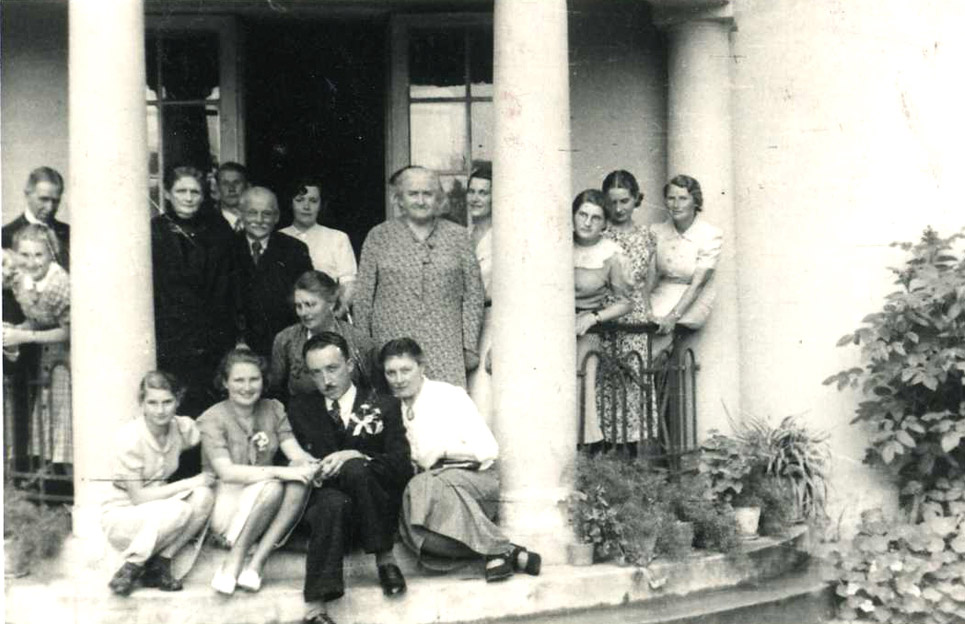Many members of my family had tumultuous lives, from experiencing the glamorous 1920s art scene in Paris, to the trauma of Stalin’s Siberian gulags in WWII. Although my suburban London upbringing couldn’t have been more different, I have inherited my creative nature from them. Here are a few of my artistic ancestors:
My great-aunt Maria Ritter studied at the L’Ecole des Beaux Arts in Paris in the 1920’s, during the time of Post-Impressionist movement. From 1921 to 1927 she studied at the Fine Art Academy of Krakow, alongside Philosophy and Art History at the Jagiellonian University in Krakow.
She belonged the Krakow art society ‘Zwornik’, and also lived in Italy to study Fresco paintings. During the Nazi occupation she worked underground helping to feed political prisoners displaced from the East. My mother sat for this portrait below, as a little girl, and says how very difficult it was having to stay still for so long!
You can see the influence of Ritter’s French contemporaries in her work. This one particularly reminds me of Cezanne’s style. As well as painting, she directed the conservation of frescoes and designed church interiors across Southern Poland.

Maria Ritter
Here are some extracts from a book on Maria Ritter: “The historic family townhouse has been turned into a gallery and museum which is still open for visiting. The Maria Ritter Paintings Gallery and Historic Interiors, include exhibitions covering four rooms on the first floor of the historic tenement house of the Ritter family, from the turn of the 18th and 19th Century.”

My mother, Anna Lenduszko-Walles 1955
“The exhibition in the first room is a monograph exhibition of works by Maria Ritter (1899-1976), the renowned painter from Nowy Sacz, as well as elements of her studio equipment.”
~ from: Maria Ritter Museum & Gallery website

Maria Ritter
“The corner “green” living room is in the Biedermeier interior style, while the white living room introduces the atmosphere of
historic apartments. The last room of the exhibition is a bedroom in the Louis Philippe I style with the Viennese portraits of Maria Ritter’s grandparents.”



Dr Konstanty Prus-Wisniewski
My great-grandfather lectured at Krakow University and also loved painting.
As well as painting some frescoes on the walls of his home (pictured below), he enjoyed producing images of Krakow. Here he depicts his favourite corner of the city (which happens to be my favourite corner too).
St Barbara’s Church was built in the 14th Century and lies between the main square and the famous St Mary’s church.
Much later, Maria Ritter added the figures into the foreground herself.


Prus-Wisniewskis 1886
Marriage of my great-grandparents Dr Konstanty Prus-Wisniewski and Maria Prus-Skowronska, 1902. With their family including General Major Felix Ritter Cyrus-Sobolewski von Sobolów and General Major Paul Ritter Cyrus-Soboloewski von Sobolów (back row)
My grandmother, Sofia Prus-Wisniewska, used some interesting techniques to create artwork. She and my grandfather were deported from Poland by the Russian Communists during WWII and put into Siberian gulags. Stalin didn’t want any opposition; the Polish intelligentsia and nobility posed a threat and were considered ‘enemies of the people’. Read more about the tragic Deportations to Siberia WWII
They endured harsh conditions there until they escaped 3 years later, travelling through Iran and India, and finally settling in Uganda and Kenya. They were the lucky ones.
My grandparents on the steps of the family home in Krakow, 1938 (right):

They re-built their lives and ran a successful farm in Kenya – home of the beautiful Rift valley and the Masai tribe. My father’s first words were in Swahili~ before he came to study at Kings College, London University in the 1960’s.
Inspired by the beautiful Kenyan landscapes of the rift valley, wilderness, nature and local people, my grandmother loved carving artwork into wood. Here are some of her woodworks.

Wood carving by Zofia Prus-Wisniewska/Walles



My (maternal) great-grandfather left Krakow to live in Brazil during the 1920’s and painted in his spare time. As a Geologist, he studied the Amazonian jungles discovering oil, and took photographs of previously undiscovered Amazonian tribes who had never seen Western man.
He loved discovering the Brazilian culture, language, and exotic landscapes – which he loved to paint.
Rather unfortunately, his wife nagged him so much about the humidity and heat, that they returned back to Poland in 1939…



